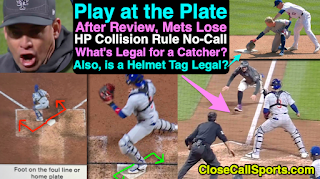Alternate Link: Mets lose on HP collision review, a poorly written rules memo, and helmet tag
Thursday, May 2, 2024
Cubs-Mets Ends with Plate Blocking No-Call & Legality of Removing a Helmet
After Chicago cut down New York's tying run Pete Alonso at home plate to secure a 1-0 win, Mets manager Carlos Mendoza challenged HP Umpire Charlie Ramos' out call, asserting that Cubs catcher Miguel Amaya illegally blocked runner Alonso's path in violation of the home plate collision rule. Replay Review ultimately upheld the on-field out call, ruling that video evidence did not conclusively demonstrate that Amaya violated the home plate collision rule.
We also look at the follow day's case of Cubs runner Pete Crow removing his helmet during play to touch second base, and being declared safe by 2B Umpire Carlos Torres, finding the Official Baseball Rules and MLB Umpire Manual alike do not address this peculiar case. That leaves the case of voluntary helmet removal (not 'detached equipment' since that's a defense rule; not interference as the helmet was not thrown at the ball) subject to elastic clause Rule 8.01(c): "Each umpire has authority to rule on any point not specifically covered in these rules."
As for the home plate collision no-call to end the prior game, since its baseball debut in 2014, then known as Posey Rule 7.13, the home plate collision rule has undergone several revisions regarding interpretation, but the fundamentals of this rule remain the same.
Alternate Link: Mets lose on HP collision review, a poorly written rules memo, and helmet tag
Official Baseball Rule 6.01(i)(2) states, "Unless the catcher is in possession of the ball, the catcher cannot block the pathway of the runner as they are attempting to score. If, in the judgment of the umpire, the catcher without possession of the ball blocks the pathway of the runner, the umpire shall call or signal the runner safe."
OBR 6.01(i)(2) also contains an exception for fielding the throw: "Notwithstanding the above, it shall not be considered a violation of this Rule 6.01(i)(2) if the catcher blocks the pathway of the runner in a legitimate attempt to field the throw (e.g., in reaction to the direction, trajectory or the hop of the incoming throw, or in reaction to a throw that originates from a pitcher or drawn-in infielder)."
The current working interpretation of the home plate collision rule considers where the catcher initially positions themself prior to receiving the throw—if the catcher sets up legally, there is a lesser likelihood their position will be considered illegal, while a catcher blocking the runner's path from the get-go will more likely be ruled for a violation.
Over the years, the foul line running between home plate and third base has been used as a delineation marker to determine whether or not a catcher is blocking the runner. If the catcher cedes the entirety of foul territory to the runner, the catcher is more likely to be ruled legal than if the catcher straddles the line or similar.
In either case, a catcher is permitted to block a runner's path in a legitimate attempt to field the throw, as well as while possessing the ball after catching it.
The Cubs-Mets case all comes down to the catcher's initial position, which is entirely on the fair territory side of the foul line and behind the leading edge of home plate, relative to the baserunner sliding from the direction of third base. Because the initial position is deemed legal (no, there exists no rule that makes it illegal for the catcher's foot to be on home plate), Replay Review confirms HP Umpire Ramos' collision violation no-call while the out/safe issue of whether Alonso was tagged in time results in a call stands outcome, an out call to end the game.
Video as follows:
Alternate Link: Mets lose on HP collision review, a poorly written rules memo, and helmet tag
Labels:
Articles
,
Ask the UEFL
,
Carlos Torres
,
Charlie Ramos
,
HP Collision
,
Rule 6.01
,
Rule 8.01
,
UEFL
,
Umpire Odds/Ends
,
Video Analysis
Subscribe to:
Post Comments
(
Atom
)













